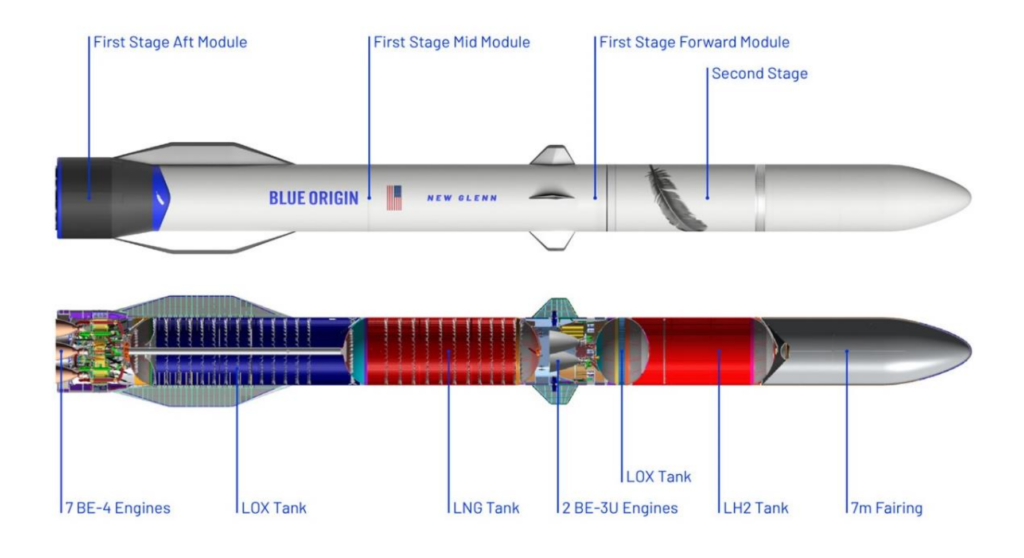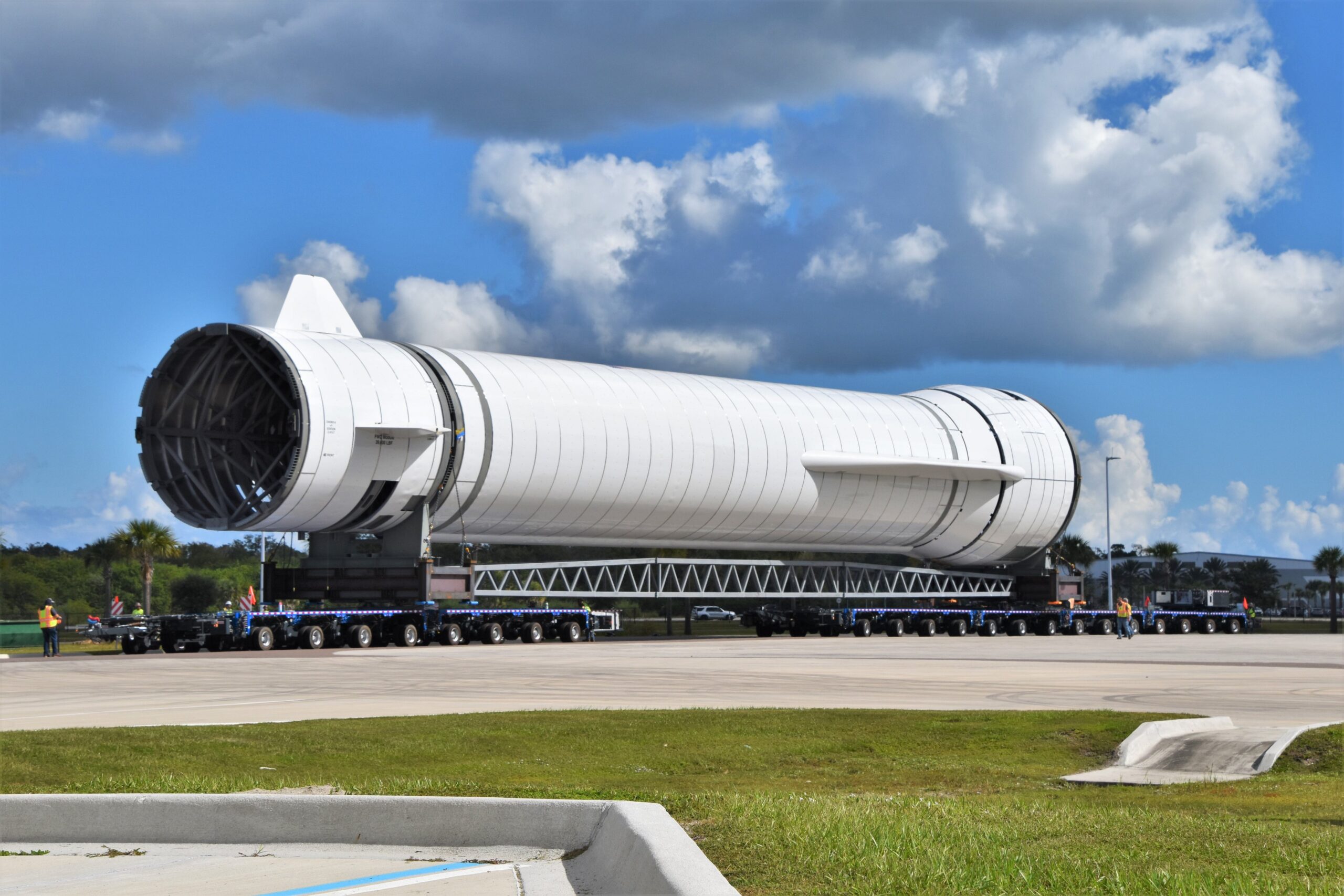
A Closer Look At New Glenn & Its Progress
Many different companies within the space industry are working on new and ambitious projects for the future. Blue Origin is no exception with the development of New Glenn. While this next generation launch vehicle has experienced quite a few delays, the company is continuing to work and attempting to launch the rocket for the first time not very long from now.
New Glenn is special for many different reasons. Whether you are looking at the design or aspects of reusability, Blue Origin is trying to change how we access space. These ambitious goals are great for the future, but also bring along a lot of risks. The company has had success with New Shepard however this is a completely different obstacle.
Different features of New Glenn make the launch vehicle stand out from others within the industry. This includes its power, configuration, performance, etc. All of which combines into a single rocket with a lot of expectations for the future. Here I will go more in-depth into some of the progress Blue Origin has made, delays, the design of the rocket, and more.
New Glenn Progress & Delays

While Blue Origin is less transparent than some other companies within the space industry, they still have provided a few updates over time regarding their launch vehicle and plans for the future. Back in late 2021, Blue Origin tweeted saying, “As #NewGlenn makes progress towards first flight, testing with the GS1 simulator will enable the team to practice ground ops for New Glenn’s massive first stage including the transport from the rocket manufacturing complex to LC-36 for integration.” In addition to this tweet, even more recently we found out that New Glenn had been selected by Amazon for up to 27 launches carrying satellites for the Kuiper constellation. Within the next few years, these launches are expected to happen are require launch vehicles such as New Glenn to be up and running. The rocket has had some delays in recent years continuing to push the inaugural launch date further away. Based on current progress, it’s likely we will not see New Glenn lift off until 2023 or later. That being said, Blue Origin is still making progress on the next generation launch vehicle. As we know New Glenn will be powered by 7 BE-4 engines on the first stage. In the last week alone, Blue Origin has provided many updates on this engine and the milestones the company has reached. One tweet on May 2nd highlighted that, “PQE-602 was the first of Blue Origin’s flight-configuration BE-4 engines that we assembled and tested, achieving consistent and repeated mission duty cycle hot fires for over 2,500 seconds of test.” Lastly, on May 3rd, they tweeted mentioning, “Earlier this year, a BE-4 flight-configuration engine gimballed 8 degrees while operating at 100% power level.” This included a GIF of the engine firing on the test stand at different angles. Tests like these will have a direct impact on New Glenn’s future and its ability to perform ambitious goals such as landing on a moving ship.
New Glenn Features

Now that we know some of the recent progress the engine and its main components have made, we can take a closer look at the rocket itself and some of its features. New Glenn, named after pioneering astronaut John Glenn, is a single configuration heavy-lift launch vehicle capable of carrying people and payloads routinely to Earth orbit and beyond. Featuring a reusable first stage built for 25 missions, New Glenn is intended to build a road to space. The goal with reusability is to decrease costs and improve access to space. New Glenn’s fully reusable first stage is designed for a minimum of 25 flights, making it competitive for a variety of launch markets. In addition, New Glenn is considered a cost-competitive system with high availability. The 7-meter fairing has two times the payload volume of any existing launch vehicle, which means more room for satellites and the freedom to build in more capacity. New Glenn is also able to launch and land in 95% of weather conditions, making it a reliable option for payload customers. The flight profile highlights the ambitious goals of the rocket. Here, New Glenn lifts off from Launch Complex 36 at Cape Canaveral. Following stage separation, the first stage flies back to Earth and lands nearly 1,000 km downrange on a moving ship, allowing the booster to land in heavy sea-states. The second stage engines ignite and the 7-meter fairing separates. The mission is complete when the payload onboard is delivered safely to orbit. In order to achieve this goal, the top and bottom of the booster feature fins and strakes. The fins at the top are actuated aerodynamic control surfaces used for altitude adjustment during descent. The strakes provide lift and cross range for the booster as it flies back towards Earth.
The New Glenn primary booster is an operationally reusable first stage with a length of 57.5 m and a tank diameter of 7 m. The stage consists of three sections: aft, mid, and forward. The aft module of the booster contains seven BE-4 LOX/LNG engines with 3,850,000 pound force total thrust at sea level. The restartable BE-4 engines provide precision thrust vector control and continuous deep throttle capability to support propulsive deceleration and landing maneuvers, while featuring long design life. The 8.5 m diameter engine skirt protects the engines from atmospheric reentry conditions and contains six stowed landing gear. The mid module of the booster houses the fuel (LNG) and oxidizer (LOX) tanks. The tanks are made of orthogrid aluminum and are designed to withstand the high g-loads realized during reentry. Large aerodynamic strakes on the aft end of the tanks give the returning first stage enhanced cross-range during descent and reentry. The forward module of the booster features four actuated aerodynamic control fins for attitude control during descent. This section of the booster also provides ground umbilical connections for New Glenn and interstage housing of the two second stage vacuum-optimized BE-3U engines. The forward module houses various guidance navigation & control avionics, including an autonomous flight safety system. The pneumatic pusher stage separation system, which provides positive separation before second stage ignition, is located in the forward module.
The second stage is an expendable LOX/LH2 stage with dual gimballing BE-3U engines with 1,060 kN total thrust in vacuum. The stage also has a tank diameter of 7 m and uses common tooling with the first stage to reduce recurring cost. The length of the second stage tank is 16.1 m and the overall length including the two high expansion ratio nozzle BE-3Us is 23.4 m. Similar to the first stage, the second stage has aft, mid, and forward sections. The aft section consists primarily of the two BE-3U engines, associated load bearing cross-bar thrust structure, and tankage/equipment for long duration operations. The reaction control system (RCS)/settling system uses tri-axial thrusters distributed in four places along the thrust structure. The second stage aft section integrates with the first stage forward section and provides one of two second stage umbilical interfaces. The mid-section contains all propellant tankage including a forward LH2 tank and an aft LOX tank, separated by a common insulated bulkhead. The tank barrels are orthogrid aluminum construction, and the domes are constructed from welded aluminum. A single external insulated LH2 supply line passes around the LOX tank.
At the very beginning of launch, the engines throttle up to partial thrust, at which point built-in-test diagnostic software analyzes the performance and health of each engine. Upon verification of nominal conditions, the flight computer issues a final “commit to launch” command, which permits full engine throttle. The transporter erector tips back out of the flight cone, hold down mechanisms release, and New Glenn lifts from the launch pad, detaching all launch vehicle umbilical. For a nominal 250 km perigee altitude GTO mission, the first stage booster initiates an engine shutdown sequence at a mission elapsed time (MET) of 199 seconds. The command induces the BE-4 main engine cut-off (MECO), and thrust tails off until second stage separation occurs at MET 202 seconds. The first stage then reorients for atmospheric reentry, landing, and recovery. The first burn for the second stage BE-3U engines starts once adequate distance between the stages is achieved, at approximately MET 206 seconds. Once passing the desired limit for aerodynamic heat flux to the payload at approximately MET 216 seconds, the payload fairing is jettisoned and the stage continues to sustain powered flight with the un-encapsulated payload. All of which works together to try and make New Glenn a unique and powerful future option for accessing space.
Conclusion
Many different companies within the space industry are working on new and ambitious projects meant to change how we access space. Blue Origin is no exception with the development of New Glenn. While this launch vehicle has experienced quite a few delays over time, the company is continuing to make progress and working towards the first ever launch. We will have to wait and see how it progresses and the impact it has on the space industry.
